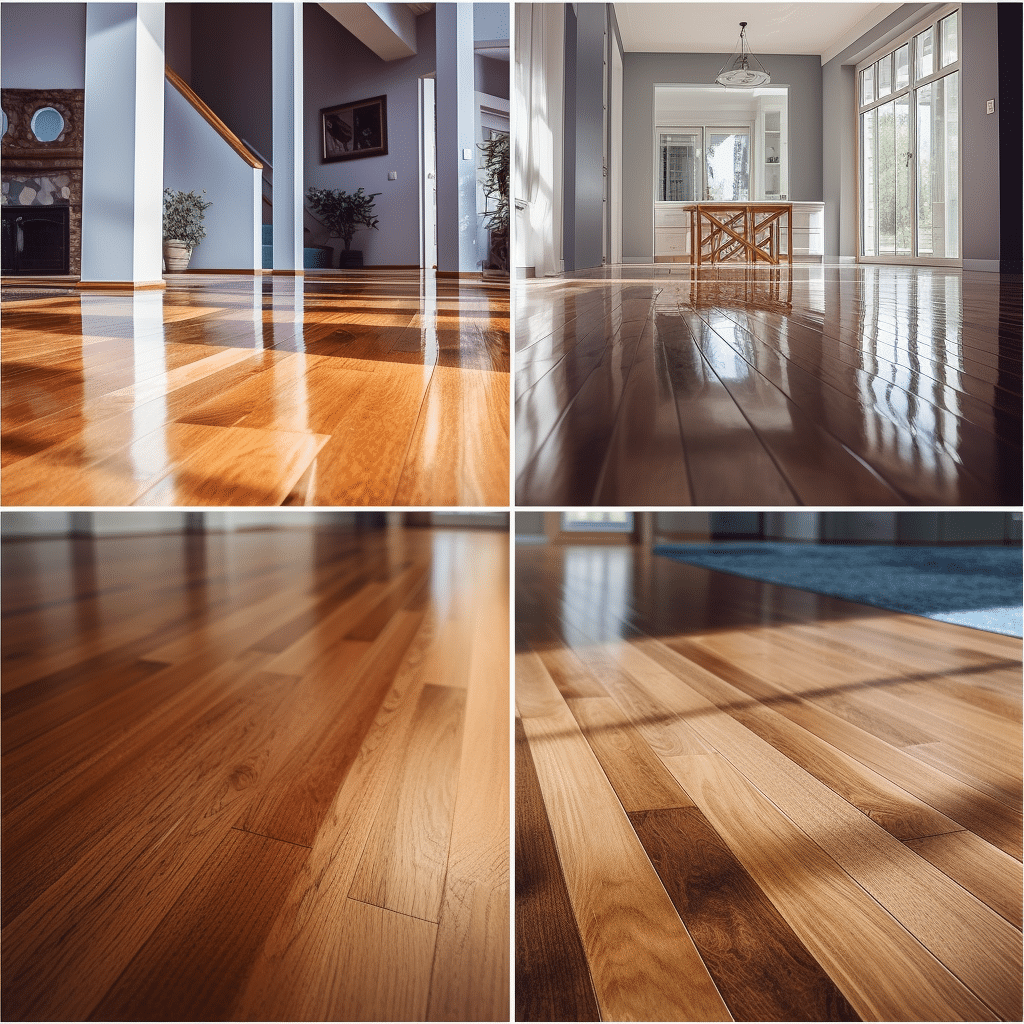.jpg)
Table of Contents
Introduction to flooring options
Flooring options are key for a space’s overall look and usability. From luxurious hardwood to budget-friendly laminate, there’s something for every taste.
Hardwood is beautiful and long-lasting, adding class and finesse to any room. Laminate flooring is a great alternative; it looks like wood, but resists scratches and is easy to clean.
Bamboo is a good eco-friendly choice. It grows quickly and can be harvested sustainably. Cork floors provide a unique texture and are naturally resistant to mold and mildew.
Vinyl flooring is a great option for those looking for affordability and style. It mimics other materials, like stone or tile, but is much cheaper. Plus, it’s water-resistant, so it’s perfect for kitchens and bathrooms.
The right flooring depends on personal needs, such as durability or budget. Research each choice before making a decision. Consider consulting with professionals who know best. With the right flooring, you can create a space that reflects your style and meets all your practical needs.
Key factors to consider when choosing flooring
Choosing flooring involves considering various factors that affect the look and feel of your space. Things to take into account include the material, durability, maintenance, cost, and aesthetics. Furthermore, don’t forget about acoustics! Carpet or cork can help reduce noise and add comfort.
My friend faced a dilemma when deciding between hardwood and vinyl for her living room. After much thought, she chose hardwood because of its beauty and warmth. This was an investment that paid off; it instantly improved the atmosphere of her home.
Think carefully about your flooring choice. Consider factors like material, durability, cost, and aesthetics. If you want something natural, look for natural flooring options.
Natural flooring options
Bamboo: A grass that grows fast, bamboo is both durable and renewable. Its colors and styles make it suited for various design tastes.
Hardwood: Natural hardwood floors add warmth and elegance to any room. It can last for generations with proper care. There are a wide range of wood species to choose from, each with its own grain pattern.
Cork: From cork oak trees without harming them, cork flooring is soft and provides excellent insulation. Its natural variations in pattern add visual interest.
Linoleum: Natural materials such as linseed oil, cork powder and wood flour make linoleum flooring biodegradable and hypoallergenic. It comes in many colors and patterns to suit different aesthetics.
Sisal and jute are other natural flooring options with durability and texture. Sisal fibers come from the leaves of the agave plant, while jute is from the jute plant’s stem. Low maintenance and resistant to stains, these eco-friendly choices can last for years while enhancing the look of your home or office.
Natural flooring dates back centuries when stones and dirt were used. As civilization advanced, wood became more popular due to its abundance. Now, with increased awareness of sustainability, natural flooring has seen a resurgence in popularity.
For style and environmental responsibility, natural flooring options are the way to go. They look beautiful and respect the world we live in. Forget real wood – synthetic options are just as good at hiding those embarrassing stains!
Synthetic flooring options
Synthetic flooring has plenty for homeowners looking for durability and style. Let’s explore these choices! Check out the table below for the types of synthetic flooring.
| Type | Material | Benefits |
|---|---|---|
| Vinyl flooring | PVC (Polyvinyl Chloride) | Waterproof, low maintenance, range of designs and colors. |
| Laminate flooring | High-density fiberboard (HDF) with a laminated surface layer | Cost-effective, easy installation, scratch-resistant. |
| Linoleum flooring | Natural materials such as linseed oil, wood flour, and cork dust | Eco-friendly, antimicrobial properties, durable. |
Let’s dive into the details of these synthetic flooring options. Vinyl flooring stands out with its ability to look like hardwood or stone, but with better moisture resistance. Laminate flooring is popular due to its affordability and scratch resistance. And, linoleum flooring boasts natural ingredients that make it an eco-friendly choice while providing durability.
It’s interesting that vinyl flooring was developed in the 1930s as a cheaper option than rubber floorings for hospitals. But, with technology developments, vinyl is now a fashionable choice for homeowners.
Choosing an eco-friendly flooring option is like saying goodbye to your interior design dreams, but hey, the planet will thank you!
Environmental impact of flooring choices
Regarding the environmental impact of flooring, it is important to assess the materials used and their possible consequences. Here, we have a breakdown of the various flooring options and their corresponding environmental implications:
| Flooring Type | Environmental Impact |
|---|---|
| Hardwood | Could lead to deforestation and habitat destruction if not sourced sustainably. |
| Bamboo | Presents an eco-friendly option, as it grows and regenerates quickly. |
| Cork | Obtained from the bark of cork oak trees, making it a renewable resource. |
| Vinyl | Has negative impacts on the environment due to production, and disposal difficulties. |
| Laminate | Made of non-biodegradable synthetic materials, posing disposal issues. |
| Carpet | Includes non-renewable resources such as fossil-fuel-based fibers, with associated health risks due to the off-gassing of the material. |
In addition, it is worth noting that certain flooring types, like hardwood and bamboo, can be resurfaced or reused instead of replaced. This reduces waste and increases the lifespan of the flooring. A noteworthy fact is that more than 90% of carpets in the U.S. are built from synthetic fibers from petroleum (source: Carpet and Rug Institute).
Choosing the right flooring for each room is like dating. You need to find the ideal match that can handle spills, stains, and foot traffic without complaint.
Factors to consider for different rooms
🎯 Table:
Choose flooring for rooms wisely. Consider these factors:
| Room Type | Factors |
|---|---|
| Living Room | Comfort, Style, Durability |
| Bedroom | Softness, Noise Insulation |
| Kitchen | Stain Resistance, Maintenance |
| Bathroom | Moisture Resistance, Slip Resistance |
Also, check room requirements. For example, bedrooms need floorings with good acoustics for peaceful sleep.
Pro Tip: Prioritize safety and functionality in wet areas like bathrooms. Choose slip-resistant floorings.
Flooring trends come and go. But, you can always count on tripping over your feet.
Popular trends in flooring
Design is always evolving, and so is the flooring industry! New trends are bringing us innovative flooring choices that add beauty and functionality. Let’s explore these exciting options and what makes them stand out.
Eco-friendly flooring like bamboo, cork, and reclaimed wood are becoming popular. They’re durable and offer a warm touch to any room. Another trend is luxury vinyl planks which are versatile, affordable, and low-maintenance.
Metallic finishes in flooring are also trending. Silver, copper, and other metals create a stunning visual impact that makes any space look modern and luxurious.
Don’t miss out on the opportunity to upgrade your space with these trendy choices. Choose the perfect partner for your flooring – they need to look great, and handle your never-ending clumsiness!
Conclusion: Making the right flooring choice for your needs
Choosing the right flooring is key to making a functional, attractive space. Durability, maintenance, and budget should be taken into account. Every type of flooring has its own advantages – it’s important to prioritize.
Think about the room’s purpose. High-traffic areas like hallways or kitchens need durable, easy-to-clean flooring, such as ceramic tile or vinyl. On the other hand, bedrooms and living rooms are perfect for carpeting, which is cozy and comfortable.
Maintenance is also an important factor. Hardwood or tile needs regular cleaning and may require refinishing. Laminate or vinyl, on the other hand, is easy to clean with just a damp mop.
Price is a must-consider too. Hardwood can be pricey, but it adds value and lasts with proper care. Laminate or vinyl can give similar looks at a better price.
Let me tell you a story about my friend Sarah. She was deciding between tile or hardwood for her kitchen renovation. After considering various factors, she went with ceramic tile as it’s resistant to stains and scratches, plus looks elegant.


